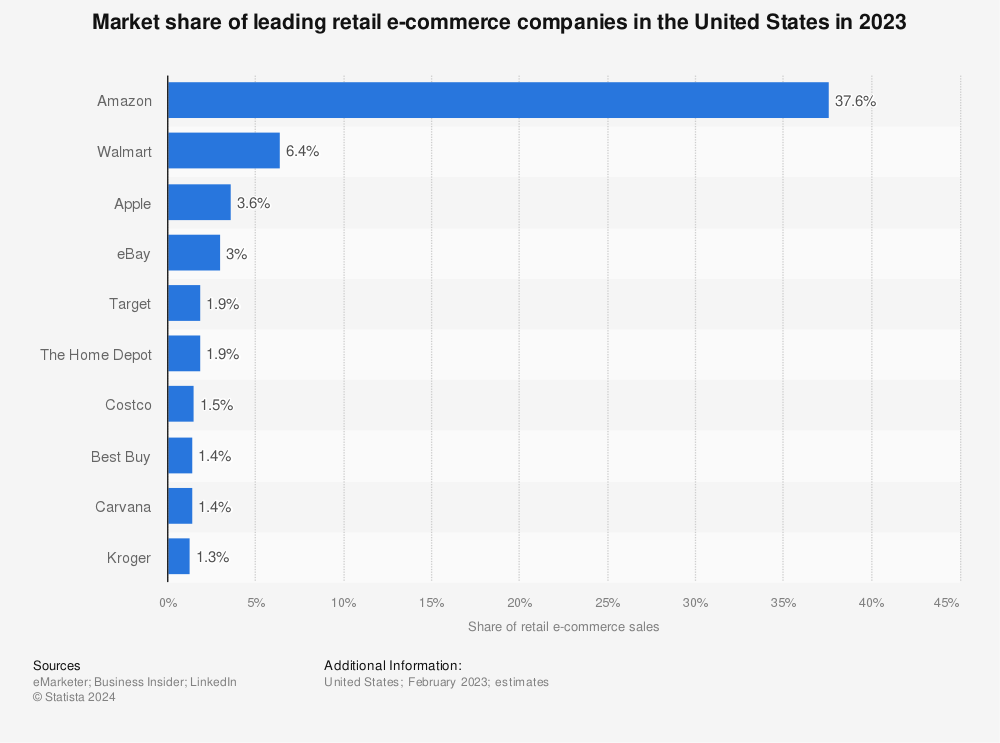New year, new world of opportunities for e-commerce sellers.
Amazon sellers should be gearing up for a new year filled with opportunities and challenges as we reflect on the past and look to the future.
Look back to 2023
In 2023, Amazon maintained its stronghold as the leading online retailer in the United States, capturing an impressive 37.6 percent of the market share, according to Statista. This dominance places Amazon far ahead of its closest online marketplace competitors, with Walmart holding second place with a 6.4 percent market share.
The rise of online shopping has driven Amazon's growth and the e-commerce industry's expansion. Over the past decade, online shopping has experienced significant growth, with more consumers turning to the internet for their purchasing needs. In 2023, the U.S. e-commerce industry reached nearly a trillion dollars in value, a testament to the increasing preference for online retail. Forecasts indicate that by 2027, the online market is expected to grow to over 50 percent of total retail sales, highlighting the continuing shift towards digital commerce.
Looking forward to 2024
As Amazon sellers embark on the journey into 2024, they do so in a marketplace shaped by Amazon's unparalleled influence and the evolving preferences of online shoppers. Here are some basic strategic resolutions to drive growth and success in the Amazon marketplace in 2024.
Resolution 1: Prep for Amazon Vendor Negotiations (AVN) and Have a Backup Plan
Within the complex ecosystem of Amazon, sellers need to prepare for negotiations with the platform as part of the Amazon Vendor Negotiations (AVN) process, understanding the importance of honing their negotiation skills and having contingency plans in place. According to a survey by Feedvisor, 78% of Amazon sellers plan to enhance their negotiation strategies in 2024, recognizing the pivotal role negotiations play in their business success.
AVN are a critical aspect of a seller's relationship with Amazon, and preparing for these negotiations can significantly impact a seller's success on the platform. Here are a few insights into navigating AVN effectively:
Understanding Amazon's Goals: Before entering negotiations, it's essential to understand Amazon's objectives and priorities. This includes clearly understanding Amazon's strategies, initiatives, and expectations for its vendor partners.
Data-Driven Approach: Leveraging data and analytics is crucial for informed negotiations. Sellers should analyze their sales data, market trends, and performance metrics to identify strengths, weaknesses, and areas for improvement. This data-driven approach can help sellers articulate their value proposition and negotiate from a position of strength.
Building Relationships: Building and nurturing strong relationships with Amazon's vendor management team can be instrumental in successful negotiations.
Pricing and Terms: Pricing and terms negotiations are central to AVN. Negotiating favorable terms that align with business objectives while meeting Amazon's requirements is crucial for long-term success.
Having a Backup Plan: Negotiations may not always go as planned despite thorough preparation. Having a backup plan in place to address unforeseen challenges or potential roadblocks is a must. This could involve alternative strategies, contingency measures, or fallback positions to protect a seller's interests.
Resolution 2: FBA Inventory Deadlines for Major Shopping Events - Considering Amazon's New Minimum Inventory Level Metric
As major shopping events like Prime Day and the holiday season continue to drive significant sales, sellers should prioritize the management of their Fulfilled by Amazon (FBA) inventory. By doing so, sellers can capitalize on these high-demand events without running out of stock. Data from Jungle Scout indicates that 63% of sellers faced inventory challenges during peak periods in 2023, highlighting the need for careful planning.
In December 2023, Amazon announced a new Minimum Inventory Level metric designed to help FBA sellers plan their inventory more effectively, improve delivery speeds, and avoid low-inventory-level fees.
The new metric, powered by advanced machine learning models, analyzes demand forecasts and replenishment settings to recommend the minimum number of units per product that sellers should have on hand in Amazon's fulfillment centers. By maintaining inventory levels above the Minimum Inventory Level, sellers can meet customer demand more effectively and offer faster delivery speeds, as products can be distributed across local fulfillment centers closer to customers.
Amazon reports that sellers who maintain inventory above the Minimum Inventory Level see an average 15% increase in sales over a four-week period, highlighting the potential impact of this new metric on sales performance. This development underscores the importance of strategic inventory planning, especially during peak shopping periods, to capitalize on sales opportunities and avoid potential penalties such as the low-inventory-level fee.
The Minimum Inventory Level metric complements existing tools and metrics available to FBA sellers, such as historical days of supply, the Inventory Performance Index (IPI), capacity limits, and restock recommendations. These resources collectively enable sellers to manage their FBA inventory efficiently, optimize their performance metrics, and navigate the complexities of inventory management in the Amazon marketplace.
Resolution 3: Optimize Current Listings
Amazon listing optimization is critical to maximizing visibility and conversion for products on the platform. Research by former Sellics, now Perpetua, shows that optimizing listings can lead to an average increase in sales of 30%. Brand Builder University listed the following key strategies for optimizing Amazon listings effectively in 2024.
Keyword Research and Optimization: Effective keyword research is fundamental to Amazon listing optimization. Sellers should identify relevant keywords that align with their products and target audience, incorporating them strategically into listing titles, bullet points, descriptions, and backend search terms. This strategic use of keywords can improve search visibility and attract relevant traffic to product listings.
Compelling Product Descriptions: Product descriptions are crucial in informing and persuading potential customers. Brand Builder University emphasizes the importance of crafting compelling and informative product descriptions that highlight key features, benefits, and unique selling points. Clear and concise descriptions can enhance customer understanding and encourage purchase decisions.
High-Quality Images and Multimedia: Visual elements such as images and videos are essential for Amazon listings. It is recommended to use high-quality images that showcase products from multiple angles and clearly represent their features. Additionally, multimedia content such as videos can engage customers and offer a more immersive shopping experience.
Competitive Pricing and Offers: Pricing and promotional offers can influence customer perception and purchasing behavior. Brand Builder University advises sellers to carefully consider their pricing strategy, considering factors such as competition, value proposition, and perceived customer value. Strategic pricing and compelling offers can help differentiate products and drive sales.
Customer Reviews and Feedback: Customer reviews and feedback are valuable social proof elements that can influence buying decisions. Brand Builder University highlights the importance of actively managing customer reviews, responding to feedback, and maintaining a positive reputation. Positive reviews can build trust and credibility, contributing to higher conversion rates.
Resolution 4: Increase Efficiency by Using Amazon’s Generative AI to Write Product Descriptions
In September 2023, Amazon introduced a new tool that allows sellers to leverage generative AI to write product descriptions, offering significant potential for increasing efficiency and productivity. The tool, powered by advanced machine learning algorithms, is designed to assist sellers in creating high-quality, engaging product descriptions that resonate with customers. Sellers should leverage this tool to free up time for more strategic tasks.
Key Insights from Amazon's new AI capabilities:
Enhanced Product Descriptions: Amazon's generative AI tool enables sellers to generate product descriptions tailored to their specific products and target audience. The tool uses natural language processing to understand the context and characteristics of each product, allowing it to create informative and compelling descriptions.
Time-Saving Benefits: By automating the process of writing product descriptions, sellers can save valuable time and resources that would otherwise be spent on manual content creation. This time-saving benefit allows sellers to focus on other aspects of their business, such as product development, marketing, and customer service.
Consistency and Quality: The use of generative AI ensures consistency and quality in product descriptions, maintaining a standardized level of professionalism across a seller's product catalog. This consistency can contribute to a more cohesive brand identity and improved customer trust.
Adaptability and Customization: Amazon's generative AI tool is designed to be adaptable and customizable, allowing sellers to tailor the generated descriptions to meet their specific needs and preferences. Sellers can input key information and style preferences to ensure the generated descriptions align with their branding and messaging.
Competitive Edge: By embracing advanced AI technology for content creation, sellers can gain a competitive edge in the marketplace. Producing high-quality product descriptions efficiently can improve search visibility, customer engagement, and, ultimately, sales performance.
Resolution 5: Consider All Options: 1P, 3P, or a Hybrid Strategy
In business strategy, no matter how long an Amazon Seller has been in the game, sellers should evaluate their options within the Amazon marketplace, including the third-party (3P) model, which has shown remarkable growth and success. Amazon's third-party marketplace has seen significant traction, with 60% of paid units sold by third-party sellers in the third quarter of 2023, according to data published by Statista.
The 3P model offers sellers several advantages over the traditional first-party (1P) model. While 1P sales involve vendors sending their inventory to Amazon, which controls pricing and displays "ships from and sold by Amazon.com" on product listings, 3P sales allow individuals and professional sellers to list and sell their products directly on Amazon Marketplace. Sellers using the 3P model have more control over pricing, which can lead to improved margins, better payment terms, and reduced reliance on the relationship with Amazon.
Additionally, the flexibility of fulfillment options such as Fulfillment by Amazon (FBA) and Fulfillment by Merchant (FBM) further enhances the appeal of the 3P model. With FBA, sellers can leverage Amazon's logistics infrastructure for storage, packing, and shipping, while FBM gives sellers more control over the fulfillment process.
The success of the 3P model is evident in Amazon's financial performance, with the e-commerce giant generating approximately 103.4 billion dollars in third-party seller services in 2021, representing a significant increase from the previous year. Special events like Black Friday, Prime Day, and Amazon Summer Sale have been key drivers of sales increases for Amazon sellers, highlighting the potential for sellers to capitalize on these events through the 3P model.
In the context of the COVID-19 pandemic, Amazon Prime Day played a crucial role for small and medium-sized businesses worldwide, many of which relied on online sales to survive. This underscores the resilience and adaptability of the 3P model, making it an attractive option for sellers looking to navigate uncertain market conditions.
Sellers considering their strategies for 2024 should carefully weigh the benefits of the 3P model, including its flexibility, improved margins, and the potential for growth in Amazon's thriving third-party marketplace.
As Amazon sellers embark on their journey into 2024, they are armed with strategic resolutions backed by data and insights. By focusing on negotiations, inventory management, listing optimization, technological advancements, and strategic choices, sellers are poised to navigate the complexities of the Amazon marketplace and achieve their business goals in the year ahead.
We Can Help!
Phelps UNITED is here to provide expert guidance on your Amazon selling strategy and brand advertising tips, explore our website to learn more.



